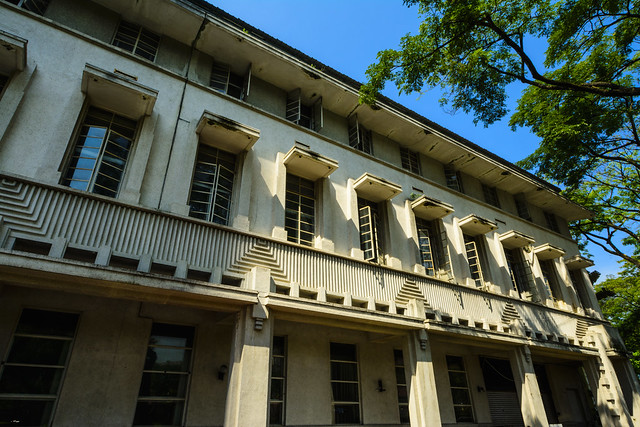Anglo-Oriental Building: A prominent landmark for the world leader in tin mining and smelting
 |
| Formerly Anglo-Oriental Building |
A British architect named Arthur Oakley Coltman (AO Coltman) was a prolific architect during his career in then Malaya. He was instrumental in designing the buildings well known for their Art Deco architectural style in Kuala Lumpur besides bringing modernism to Kuala Lumpur. He worked as manager for the architecture firm Booty, Edwards & Partners practising architecture for 32 years in Malaya. He arrived in Malaya in 1925 and retired in 1957.
The Art Deco buildings in Kuala Lumpur designed by him included Oriental Building (built in 1931), the Odeon Cinema (built in 1936), the old OCBC building (built in 1937), the Clock Tower at the Old Market Square to commemorate the coronation of England’s King George VI in 1937, the Rubber Research Institute of Malaya (R.R.I.M) Building (built in 1936), the Lee Rubber Building (built in the early 1930s) and the Anglo-Oriental Building (built in 1937).
The Anglo-Oriental Building which was completed in 1937 was the direct result of one of the two key exports from British Malaya, i.e. tin besides rubber. The Anglo-Oriental Building was occupied by Anglo-Oriental (Malaya) Ltd., a subsidiary of the Anglo-Oriental Mining Corporation (later to become known as the London Tin Corporation), the general managers for a large number of tin mines in Malaya.
 |
| Facade of the Anglo-Oriental Building Photograph by Zain Abdullah - All rights reserved. |
This Art Deco building is a three-storey building with a basement floor and has an area of approximately 1,473 square metres (0.364 acres). The building is an excellent example of Art Deco construction with extensive use of Art Deco elements and ornamentation, characteristic of the style. Situated on the corner of Jalan Tangsi (formerly Barrack Road) and Jalan Parlimen (formerly Club Road), it has a double frontage of two asymmetrical wings. The curved corner of the building houses the main entrance. Two prominent pylons with flagpoles on top flank the entry. Projecting from these pylons is a concrete canopy shading the entrance. Observe the decorative grooved pattern around the perimeter belt between the colonnade and windows. The groove and the surface finishing of this building, like other Art Deco buildings in Malaya and in Asia generally, was made with Shanghai plaster. If you would like to know more about Shanghai plaster in Art Deco finishing, I suggest you check out my fellow Malaysian’s blog which describes Shanghai plaster in details here.
The Straits Times dated 1 October 1937 reported that the main entrance doors of this elegant building would be panelled with hammered pewter – a white alloy resembling tin in appearance – which would be secured with “stay-brite” strips. The company’s name would also be executed in hammered pewter, and tin would be the motif of the treatment details. Dadoes for the staircase and entrance vestibule were made of a new material, Marbrunite, in multiple colours.
After all Anglo-Oriental (Malaya) Ltd. was the manager for a large number of tin mines in Malaya. Malaya was at that time the world’s largest exporter of tin. This also signifies the theatrical opulence which Art Deco is always associated with.
Apart from the opulence in style the Straits Times also reported that the architect had even designed a motor car garage on the ground floor to enable the office workers to park their cars inside the building to prevent parking congestion in the street! It also well means the Malaya’s economy was strong and resilient enough when the west part of the world was suffering the Great Depression at that time.
In 1988, a Malaysian renowned architect Chen Voon Fee later renovated the building for use by Mahkota College. During renovation, the internal lower roof was replaced by a reinforced concrete floor. This created a usable space in the core of the building. A ring of corridors, which wrap around the three-storey atrium, links the internal rooms.
The building was subsequently acquired by Ekran Berhad in 1995, the property developer and it was renamed Wisma Ekran. However Ekran Berhad has sold off this building in 2005 when it relocated its headquarters to Kuching, Sarawak. The building is now left vacant.
If you are a fan of Art Deco architecture especially in Malaysian context you may want to read this article entitled "The History and Influence of Art Deco in Malaysia's Architecture".
 |
Grooved pattern and slim windows of the Anglo-Oriental Building Photograph by Zain Abdullah - All rights reserved. |
 |
Grooved pattern and slim windows of the Anglo-Oriental Building Photograph by Zain Abdullah - All rights reserved. |


We stumbled over here by a different web address
ReplyDeleteand thought I might as well check things out. I like what I
see so i am just following you. Look forward to exploring
your web page for a second time.
Thanks for dropping by. We are glad if this blog could benefit you.
Delete